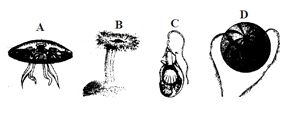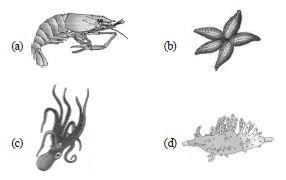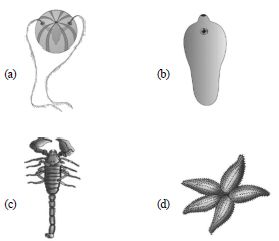Refer the types of cells present in some animals. Each cell is specialized to perform a single specific function except
Cnidocytes
Choanocytes
Interstitial cells
Gastrodermal cells
Correct Answer :
C. Interstitial cells
Interstitial cell refers to any one of a number of different types of cells characterized by their interstitial nature (i.e., their interposition between other cells that were usually characterized earlier or more completely). Cnidocytes is present in coelenterates as an organ used for prey capture and defense from predators. Choanocytes are flagellated cells, present in porifera and function as the sponge's digestive system. Gastrodermal cells are present in cnidarians and helps in digestion.
Related Questions
Tracheae of cockroach and mammal are similar in having
paired nature.
non-collapsible walls.
ciliated inner lining.
origin from head.
Which one of the following statement regarding coelom of given animals is correct?
Round worms (aschelminthes) are pseudocoelomates.
Molluscs are acoelomates.
Insects are pseudocoelomates.
Flatworms (platyhelminthes) are coelomates.
When any plane passing through the central axis of the body divides the organism into two identical halves, the organism is called ___________.
radially symmetrical
bilaterally symmetrical
asymmetrical
metamerically segmented
Match the features given in column I with their examples given in column II and choose the correct match from the option given below.
| Column-I | Column-II |
|---|---|
| (Features) | (Examples) |
| A. Pseudocoelomates | a. Hydra, Adamsia |
| B. Diploblastic | b. Ctenoplana, Aurelia |
| C. Cellular level of | c. Ascaris, Wuchereria organization |
| D. Radial symmetry | d. Sycon, Spongilla |
| E. Metamerism | e. Pheretima, Neries |
A - e, B - b, C - d, D - c, E - a
A - c, B - a, C - d, D - b, E - e
A - b, B - a, C - c, D - e, E - d
A - c, B - b, C - d, D - a, E - e
In amphibians, respiration occurs through
gills
lungs
skin
all of these
Which one of the following categories of animals is correctly described with no single exception in it?
In chondrichthyes notochord is persistent throughout life.
All mammals are viviparous and possess diaphragm for breathing.
All sponges are marine.
All reptiles possess scales, have a three chambered heart and are cold blooded (poikilothermal).
Which of the following possesses electric organs and belongs to class chondrichthyes?
Torpedo
Petromyzon
Trygon
Exocoetus
Column-I contains organisms and column-II contains their exeretory structures. Choose the correct match form the options given below.
| Column- I | Column -II |
|---|---|
| (Organism) | (Excretory structures) |
| A. Cockroach | I. Nephridia |
| B. Cat fish | II. Malpighian tubules |
| C. Earthworm | III. Kidneys |
| D. Balanoglossus | IV. Flame cells |
| E. Flatworm | V. Proboscis gland |
A I; B III; C II; D IV; E V
A III; B I; C II; D V; E IV
A II; B I; C III; D V; E IV
A II; B III; C I; D V; E IV
Which of the following group of animals belongs to the same phylum?
Earthworm, pinworm, tapeworm
Prawn, scorpion, Locusta
Sponge, Sea anemone, starfish
Malarial parasite, Amoeba, mosquito
Few cnidarians like corals have a skeleton composed of
calcium hydroxide
calcium sulphate
calcium carbonate
sodium bicarbonate
Refer the figures A, B, C and D given below. Which of the following options shows the correct name of the animals shown by the figures A, B, C and D ?

A – Locust, B – Scorpion, C – Prawn, D – Pila
A – Locust, B – Prawn, C – Scorpion, D – Pila
A – Locust, B – Scorpion, C – Prawn, D – Snail
A – Butterfly, B – Scorpion, C – Prawn, D – Pila
Which of the following statements is without exception in sponges ?
They all have calcareous spicules.
They have high regenerative power.
They are found only in marine water.
They are all radially symmetrical.
Which of the following statement(s) is/are correct?
(i) Animals in which the cells are arranged in two embryonic layers, an external ectoderm and an internal endoderm, are called diploblastic animals.
(ii) Notochord is an ectodermally derived rod like structure formed on the ventral side during embryonic development in some animals.
(iii) In some animals, the body cavity is not lined by mesoderm, instead, the mesoderm is present as scattered pouches in between the ectoderm and endoderm and such a body cavity is called pseudocoelom.
Only (i)
Both (i) and (ii)
Both (i) and (iii)
All of these
In which of the phylum, excretory organ like proboscis gland is present?
Hemichordata
Chordata
Echinodermata
Annelida
Refer the given figures A, B, C and D and identify the option which shows their correct name.

A - Pleurobrachia, B - Cnidoblast, C - Aurelia, D - Adamsia
A - Aurelia, B - Adamsia, C - Cnidoblast, D - Pleurobrachia
A - Cnidoblast, B - Pleurobrachia, C - Adamsia, D - Aurelia
A - Adamsia, B - Aurelia, C - Pleurobrachia, D - Cnidoblast
Read the following statements and answer the question.
(i) They are exclusively marine, radially symmetrical, diploblastic organisms with tissue level of organisation.
(ii) Body bears eight external rows of ciliated comb plates, which help in locomotion.
(iii) Digestion is both extracellular and intracellular.
(iv) Reproduction takes place only by sexual means.
Which of the following phylum is being described by above statements?
Platyhelminthes
Arthropoda
Mollusca
Ctenophora
Heart is three - chambered in reptiles, except
turtle
Chameleon
Naja (Cobra)
crocodile
Which of the following statement(s) is/are correct regarding phylum aschelminthes?
(i) The body is circular in cross-section hence the name roundworms.
(ii) Alimentary canal is complete with a well-developed muscular pharynx.
(iii) Sexes are separate (dioecious), i.e., males and females are distinct.
(iv) Nephridia help in osmoregulation and excretion.
(i) and (ii)
(iii) and (iv)
(i), (ii) and (iii)
All of these
Which of the following is not a characteristic feature of kingdom animalia ?
Storage of carbohydrates as starch.
Multicellularity.
Obtaining nutrients by ingestion.
Having eukaryotic cells without walls.
Hemichordates have now been placed with the nonchordates, close to echinoderms, because true
notochord is absent.
pharyngeal gill-slits are lacking.
dorsal nerve cord is absent.
heart is lacking.
Which of the following is a poisonous snake?
Naja (Cobra)
Bangarus (Krait)
Viper (Viper)
All of these
A common characteristic of all vertebrates without exception is
the division of body into head, neck, trunk and tail.
body covered with exoskeleton.
the possession of two pairs of functional appendages.
the presence of well- developed skull.
Refer the types of cells present in some animals. Each cell is specialized to perform a single specific function except
Cnidocytes
Choanocytes
Interstitial cells
Gastrodermal cells
Which of the following animal's body is covered by calcareous shell and unsegmented with a distinct head, muscular foot, and visceral hump?

Click to check answer
Click to check answer
Click to check answer
Click to check answer
Which of the following statement(s) is/are correct regarding phylum mollusca?
They are bilaterally symmetrical, triploblastic and coelomate animals.
Body is covered by a calcareous shell and is unsegmented with a distinct head, muscular foot and visceral hump.
The mouth contains a file-like rasping organ for feeding, called radula.
All of the above
Which of the following animal contains respiratory organs like, gills, book gills, book lungs or tracheal system?

Click to check answer
Click to check answer
Click to check answer
Click to check answer
Which of the following group of animals reproduces only by sexual means?
Ctenophora
Cnidaria
Porifera
Protozoa
Select the incorrect feature of mollusca from the given statements.
- Terrestrial or aquatic animals having cellular system level of organization.
- Radial symmetrical and acoelomate animals and possesses two germinal layers.
- A file like rasping organ called radula is present.
- Usually dioecious and viviparous animals.
- Examples include Pila, Octopus, and Dentalium.
(i) and (ii) only
(ii) and (iv) only
(i), (ii) and (iv) only
All the five statements.
Match the terms/feature given in column I with their examples given in column II and select the correct match from the option given below.
| Column-I | Column-II |
|---|---|
| (Term/Feature) | (Examples) |
| A. Gregarious pest | i. Hirudinaria |
| B. Vector | ii. Planaria |
| C. Oviparous with | iii. Sepia indirect development |
| D. Metameres | iv. Aedes |
| E. High regeneration | v. Locust capacity |
A - i, B - ii, C - iii, D - iv, E - v
A - iii, B - v, C - ii, D - iv, E - i
A - iii, B - i, C - v, D - ii, E - iv
A - v, B - iv, C - iii, D - i, E - ii
Which of the following is not the common fundamental feature for animal classification?
Germinal layers.
Pathway of water transport.
Pattern of organization of cells.
Serial repetition of the segments.
